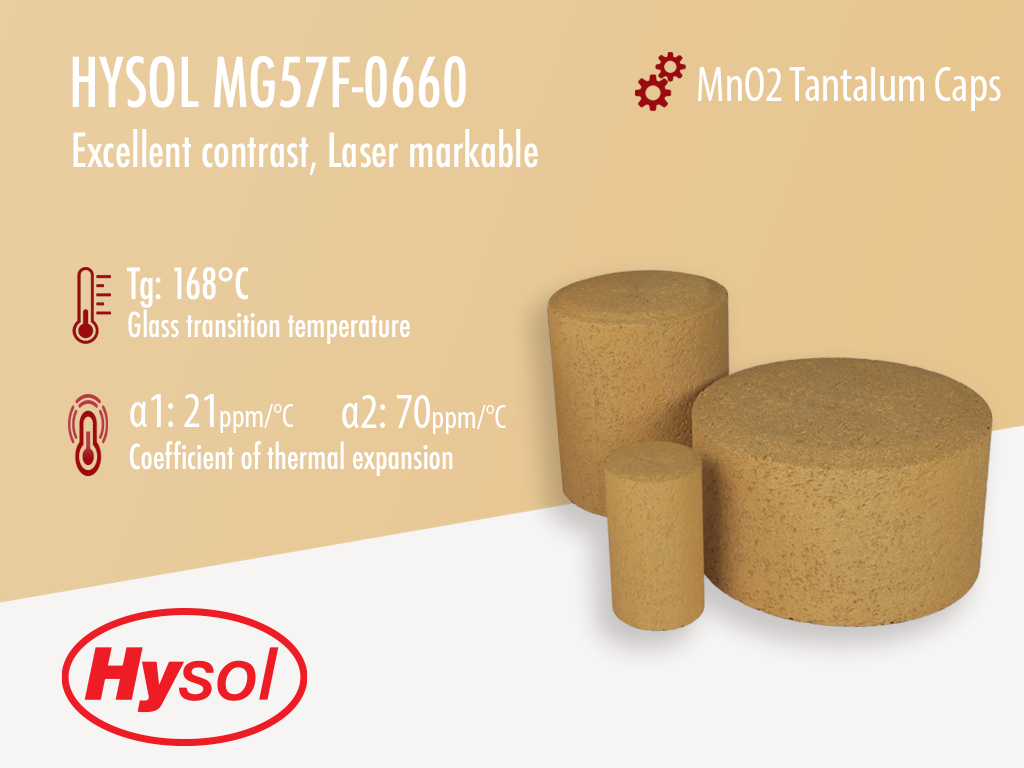Hysol MG57F-0660 | Gold Epoxy Mold Compound
- Gold epoxy mold compound
- Laser Markable
- Designed for MnO2 Tantalum Capacitors
Product Description
Hysol MG57F-0660 is a gold-colored, environmentally friendly “green” (no bromine/antimony or phosphorous) molding compound. It has been designed especially for use in high volume molding of Manganese Oxide MnO2 tantalum capacitors. It offers excellent moldability with faster cycle times than most traditional epoxy based encapsulants and is especially recommended for automold applications.
Hysol MG57F-0660 also offers excellent contrast with currently available laser marking equipment making it ideal for laser marking product information on the component.
Curing Time
- 20 to 35 seconds @170°C
- 30 to 60 seconds @150°C
Post Cure
- 2 hours @150°C
Technical Specifications
| General Properties | |||||||||||
| Color Color The color | Gold | ||||||||||
| Specific Gravity Specific Gravity Specific gravity (SG) is the ratio of the density of a substance to the density of a reference substance; equivalently, it is the ratio of the mass of a substance to the mass of a reference substance for the same given volume. For liquids, the reference substance is almost always water (1), while for gases, it is air (1.18) at room temperature. Specific gravity is unitless. | 1.82 | ||||||||||
| |||||||||||
| Chemical Properties | |||||||||||
| |||||||||||
| Moisture absorption | 0.42 % | ||||||||||
| Mechanical Properties | |||||||||||
| |||||||||||
| |||||||||||
| Electrical Properties | |||||||||||
| Volume Resistivity Volume Resistivity Volume resistivity, also called volume resistance, bulk resistance or bulk resistivity is a thickness dependent measurement of the resistivity of a material perpendicular to the plane of the surface. | 3.5x1016 Ohms⋅cm | ||||||||||
| Thermal Properties | |||||||||||
| |||||||||||
| |||||||||||
| Glass Transition Temperature (Tg) Glass Transition Temperature (Tg) The glass transition temperature for organic adhesives is a temperature region where the polymers change from glassy and brittle to soft and rubbery. Increasing the temperature further continues the softening process as the viscosity drops too. Temperatures between the glass transition temperature and below the decomposition point of the adhesive are the best region for bonding. The glass-transition temperature Tg of a material characterizes the range of temperatures over which this glass transition occurs. | 168 °C | ||||||||||
| UL 94 Rating UL 94 Rating Flammability rating classification. It determines how fast a material burns or extinguishes once it is ignited. HB: slow burning on a horizontal specimen; burning rate less than 76 mm/min for thickness less than 3 mm or burning stops before 100 mm V-2: burning stops within 30 seconds on a vertical specimen; drips of flaming particles are allowed. V-1: burning stops within 30 seconds on a vertical specimen; drips of particles allowed as long as they are not inflamed. V-0: burning stops within 10 seconds on a vertical specimen; drips of particles allowed as long as they are not inflamed. 5VB: burning stops within 60 seconds on a vertical specimen; no drips allowed; plaque specimens may develop a hole. 5VA: burning stops within 60 seconds on a vertical specimen; no drips allowed; plaque specimens may not develop a hole | V0 | ||||||||||
| Curing Conditions | |||||||||||
| |||||||||||
| |||||||||||
| Transfer Pressure | 40 - 100 kg/cm2 | ||||||||||
| Transfer Time | 5 - 30 s | ||||||||||
Additional Information
Applications
Typical applications and uses of Hysol MG57F-0660 | Gold Epoxy Mold Compound include:
Technical Datasheets for Hysol MG57F-0660 | Gold Epoxy Mold CompoundTDS (English) |
Packaging Details
The following information is specifically related to each unit of measure of Hysol MG57F-0660 | Gold Epoxy Mold Compound. If you which to compare this to other product sizes, click on the respective product from the list above and check here for values specific to that product. These values are taken from our internal database and are used in the calculation of the gross weight and packaging dimensions of the goods during shipping. You can use these values to approximate delivery charges using your own carrier. |




